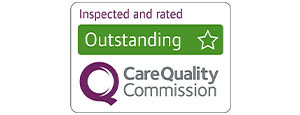When I ask you to close your eyes and imagine a nurse, what do you see?
Is it a pristine white uniform? Do they wear a hat? Are they in Navy, or Hospital Blue?
Is it a modern picture in full PPE, visor and scrubs, underneath a rainbow of thanks?
Are they a man or a woman? Are they in a hospital or at your local GP? Are they on the telly, in Holby City or Casualty?
Are they a leader? A CEO? An innovator or entrepreneur?
Are they in the courts, are they in the police station? A Clinic? A Ward?
Or are they in your home?
Dying Matters Week falls this year between 2 - 6 May, six days before the 202 anniversary of the birthday of Florence Nightingale, often considered to be the pioneer of modern nursing. This year I am drawn to her words about Community Nursing, whom she described as "the Star of Bethlehem [and] the crown of good nursing."
She described Community and Nurses as "not only the nursing of the patient, but in the nursing of the room, the teaching of the family or neighbours how to help the nurse, the teaching of how to keep in health." This resonates with me on such a personal level, as nurses we are taught about the importance of holistic care so often, that sometimes it can feel performative. But if we enact Nightingale’s words and care for not just the person but their community, their family and their home, we can truly improve the concept of public health. She had the understanding and the long-term vision that nursing closer to home empowers the person, their loved ones and the public.
Community nurses are constantly changing and growing, no longer only the ladies on the bike of BBC’s Call The Midwife. You may see them in clinics, GP surgeries, care centres, hospices and your own home. There are an increasing number of autonomous practitioners working in the community such as tissue viability nurses who care for patients with complex wounds, community psychiatric nurses who care for the most vulnerable patients with mental illness and all manner of advanced nurse practitioners, and nurse consultants, who can provide you excellence in all specialties of care.
And yet, we often feel like invisible nurses – during the pandemic there has been an understandable focus on Hospital services that those of us who work outside of the wards can often feel forgotten about. This is of detriment to patients, who may not know what services are available to them.
If we feel invisible, I worry that they feel abandoned.
I have, since my registration in 2014, had the immense honour to work with patients and their families in the community. As part of ellenor’s Hospice at Home team I have had the privilege to enter someone’s home as both a nurse, and a guest to offer them comfort and expert management of the symptons of their illness, even in the last days and hours of their life.
This Dying Matters week we are encouraged to ask ourselves “where is a good place to die?”. For many of those I care for, the best place to die is home. In familiar surroundings, with familiar people, maybe even in a familiar bed.









